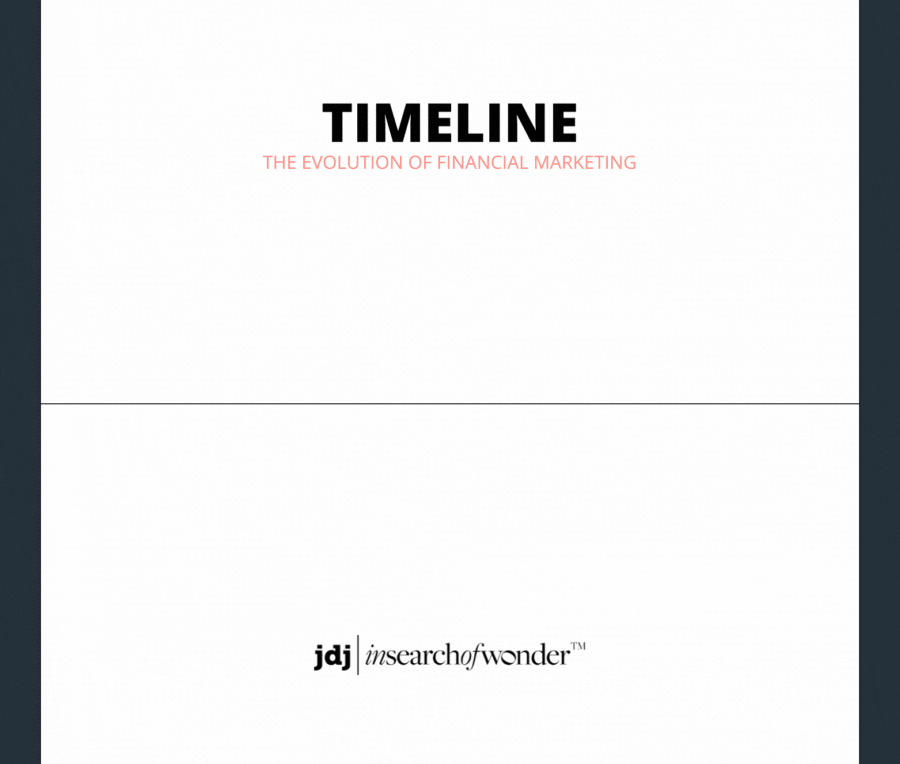Visual storytelling can be an effective way to transform the marketing efforts of financial services. In a highly regulated and complex industry, the use of engaging visuals can simplify information, providing transparent and accurate communication to build strong relationships.
Marketing for financial services is hard. A lack of tangibility means showcasing offerings such as investments or insurance cannot be done in the same way as promoting physical products. Likewise, the complex nature of the industry can be prohibitive for some audiences. For others, the information may just be too boring.
Whether through short-form social media posts, in-depth thought leadership pieces or everyday marketing communication, the use of visuals can improve accessibility, making topics relatable, informative and engaging whilst adhering to industry regulations.
In this article we look at how financial marketing has evolved, why visual storytelling works and provide tips on best practices to ensure you build trust and credibility amongst your target audience.
Over the years, financial marketing has undergone significant changes. From the pre-internet era of large billboards and radio advertising, to the recent rise of chatbots and AI, the way financial marketers reach their audience has changed.
As technology and customer expectations continue to evolve, so must the communications teams delivering their messages.

Where once messages were delivered in a blanket fashion, the rise of the internet allowed greater segmentation, with online banking and email newsletters providing bespoke advice and offers to customers.
Later still, search engine marketing and social media allowed marketers to increase their visibility and engage directly with their audience. With this came a demand for more relatable, engaging and personalised content, a trend which better data analytics facilitated, and AI models continue to implement to this day.
Alongside this shift in consumer expectations, the increased dominance of digital media led to the introduction of visual storytelling as a means to bridge the gap between complex financial information and audience engagement. Gone are the days of dense pages of text overwhelmed by data and technical jargon. Nowadays, explainer videos, interactive data visualisations, illustrations and social media content can all provide tailored information at all stages of a client’s journey.

“

Visual storytelling techniques are varied, but all share similar characteristics. They’ll be on brand, using brand colours, assets and tone of voice; and they’ll all fit into a narrative structure that guides the audience on a journey.
These techniques may involve:
These methods work because they connect emotionally with their audience, making the information they present more relatable. By highlighting real-life scenarios that resonate on a personal level, marketing becomes that much easier.
Likewise, knowing where the audience is in their individual journey allows for hyper-tailored content. Those looking to buy a home may benefit from a visual guide to getting a mortgage; while those with excess savings may enjoy an explainer video on the basics of investing.
Combining these narratives with easy-to-understand charts, graphs and infographics can be a powerful combination. By following a pre-determined story arc, marketers can guide their audience to a desired action or financial decision.
Visuals are also more memorable, helping financial messaging to stick in the audience’s mind. When using brand elements, such as colour and design choices, this can be an effective mix.
As well as being easily personalised, visuals also aid comprehension, allowing customers to see trends from themselves in ways that may be difficult through text alone. Institutions that are willing to share information in this way are therefore seen as more transparent and trustworthy.
Transcending language barriers, visuals can also be understood by financial institutions’ overseas clientele, giving them an edge in a competitive global landscape.
By connecting with customers on a deep level, financial institutions can convey their brand values and expertise effectively.
With over a decade of experience supporting Tier One financial institutions, we’re experienced in helping firms to find their niche, establish their brand position and deliver great graphic design through their commercial and marketing documents. For an informal chat, get in contact with our design team today at hello@jdjcreative.co.uk or fill in our contact form.
Share
Sign up to our monthly newsletter to receive your guide to thought leadership design.

Sign up to our monthly newsletter to receive your guide to annual report design.

Sign up to our monthly newsletter to receive your guide to sustainability report design.
